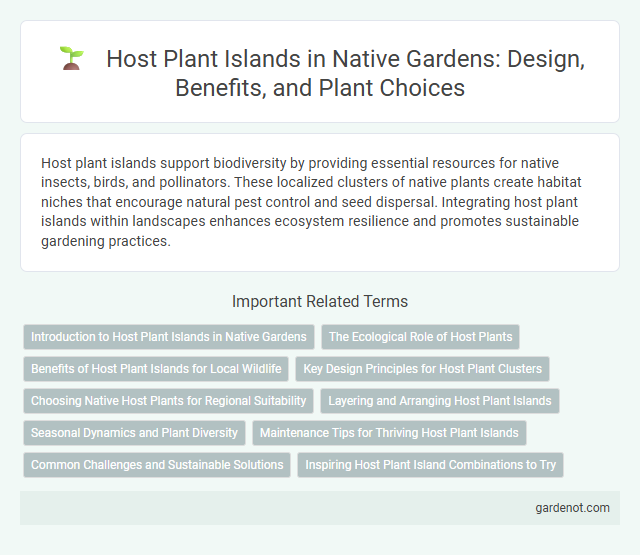Host plant islands support biodiversity by providing essential resources for native insects, birds, and pollinators. These localized clusters of native plants create habitat niches that encourage natural pest control and seed dispersal. Integrating host plant islands within landscapes enhances ecosystem resilience and promotes sustainable gardening practices.
Introduction to Host Plant Islands in Native Gardens
Host plant islands are strategically planted groups of native species that support local wildlife by providing essential food and habitat resources. These clusters enhance biodiversity, attract pollinators such as butterflies and bees, and promote healthier garden ecosystems. Integrating host plant islands into native gardens fosters ecological balance and aids in the conservation of native insect populations.
The Ecological Role of Host Plants
Host plants serve as critical ecological hubs by providing essential resources such as food, shelter, and breeding grounds for a diverse array of native insects, especially butterfly and moth larvae. These plants support the life cycles of specialized pollinators and herbivores, fostering biodiversity and nutrient cycling within ecosystems. By sustaining native fauna, host plants contribute to habitat resilience and the overall health of interconnected native plant communities.
Benefits of Host Plant Islands for Local Wildlife
Host plant islands provide essential habitat and food resources for local wildlife, supporting diverse insect populations, including pollinators and butterfly larvae. These islands enhance biodiversity by creating microhabitats that shelter birds, small mammals, and beneficial insects from urban pressures. Concentrating native plants together improves ecological connectivity, promoting healthier ecosystems and aiding in the conservation of native species.
Key Design Principles for Host Plant Clusters
Host plant islands thrive when designed with key principles such as species diversity, spatial arrangement, and microhabitat creation to support native pollinators and wildlife. Clustering multiple native host plants in close proximity enhances ecological connectivity while optimizing resource availability and shelter. Selecting species with staggered bloom times and varying growth forms maximizes habitat resilience and seasonal support for diverse insect populations.
Choosing Native Host Plants for Regional Suitability
Selecting native host plants that are regionally adapted ensures optimal growth and supports local wildlife, including specific pollinators and herbivores. Prioritize species endemic to your area to maintain ecological balance and enhance biodiversity. Native host plants require fewer resources and increase the resilience of your native planting ecosystem.
Layering and Arranging Host Plant Islands
Layering and arranging host plant islands maximize biodiversity by creating diverse microhabitats that support various butterfly and pollinator species. Native shrubs, grasses, and flowering plants are strategically placed in vertical and horizontal layers to enhance shelter, food resources, and breeding grounds. This structured design improves ecological connectivity, promoting pollinator movement and sustaining healthy populations throughout the growing season.
Seasonal Dynamics and Plant Diversity
Host plant islands enhance seasonal dynamics by providing diverse microhabitats that support various insect and pollinator species throughout the year. These islands increase plant diversity by integrating native perennials, shrubs, and grasses, which create layered vegetation structures that foster ecological resilience. The fluctuating availability of resources in host plant islands aligns with natural phenological cycles, promoting sustained wildlife interaction and biodiversity.
Maintenance Tips for Thriving Host Plant Islands
Regular monitoring of host plant islands ensures early detection of pests and diseases, promoting plant health and longevity. Mulching around native species retains soil moisture and suppresses weeds, creating an ideal environment for growth. Pruning dead or damaged foliage enhances air circulation and encourages vibrant new growth in thriving host plant islands.
Common Challenges and Sustainable Solutions
Host plant islands often face challenges such as invasive species competition, soil erosion, and water runoff that compromise native plant health. Implementing mulching techniques, planting diverse native species, and creating buffer zones help stabilize soil and enhance habitat resilience. Sustainable management involves regular monitoring and adaptive practices to maintain ecological balance and support native pollinators.
Inspiring Host Plant Island Combinations to Try
Creating vibrant host plant islands with native species supports local pollinators and enhances biodiversity. Combining milkweed (Asclepias spp.) with butterfly weed and swamp milkweed attracts monarch butterflies, while pairing native goldenrod with New England aster provides essential late-season nectar. Incorporate plants like Joe-Pye weed and black-eyed Susan to offer varied bloom times, ensuring continuous habitat and food sources for native insects throughout the growing season.
Host plant island Infographic

 gardenot.com
gardenot.com